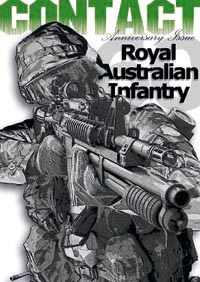| Click
on the images below for a readable .pdf of the entire story (caution - some
of these files are up to 3meg each) |
| |
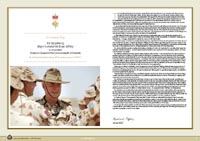 |
A
Foreword by
His Excellency
Major General Michael Jeffery
AC CVO MC (RETD)
Governor-General of the Commonwealth of Australia
for the Royal Australian
Infantry 60th Anniversary issue of CONTACT
...I
know that this infantry edition of CONTACT will be enjoyed by former and
current-serving Australian infantrymen and I hope it will also give families,
friends and other members of the community an insight into this distinguished
group of men who have given so much to our nation.
|
|
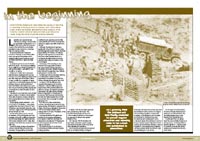 |
Until
1950 the Defence Act precluded the raising of full-time or ‘standing’
infantry, armour or cavalry units in Australia.
In fact, when the Darwin Mobile Force was raised in 1939, ‘infantry’
soldiers were actually enlisted as artillerymen – even using the
ranks of gunner and bombardier.
Legislation also prevented any soldier from serving overseas unless
he specifi cally volunteered to do so. For this reason, after the outbreak
of each of the World Wars, an Australian Imperial Force was raised on
a volunteer basis for overseas service.
The perceived threat of Japanese invasion in 1942 did see Australian militia
used overseas, but these were sent to carefully defi ned areas that were
mostly Australian territories in Papua and New Guinea.
Australia fought the Second World War with three armies – the Permanent
Military Forces (PMF), the Australian Imperial Force (AIF) and the militia
– each with its own conditions of service...
|
|
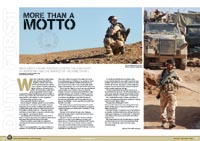 |
WHAT KEEPS
A TEAM TOGETHER DESPITE THE HARDSHIPS OF OPERATIONS AND THE WORRIES OF
THE HOME FRONT?
When I received my skippy badge after fi nishing infantry IET at Singleton,
I read its motto, “Duty First”. I heard the duty-fi rst call
from angry sergeants dispelling whingeingdigger syndrome or at army history
lectures but, at that time, I really didn’t
grasp or appreciate it. Even though I respected the badge’s signifi
cance, the history behind it and the corps it represents, I felt I hadn’t
done enough to understand the real sacrifi ces its motto engenders.
But that was then and this is now. I have seen what ‘duty first’
is all about.
I am not going to call them a platoon or even sections, for that would
not do justice to the qualities that have developed over 15 months of
training and operations together. I will simply call them a team, for
they have all the qualities a winning team has – mateship, respect,
motivation, professionalism, compassion, humour, unity and toughness –
physical and mental.
I am writing about ‘the team’ because I am proud of them, not
because they have done anything extraordinary, but because they did their
job and did it well.
When the majority came together in September 2005, little did they know
they wouldn’t be home until May 2007...
Words Private
Jonathon Morison
Pics Corporal Ricky Fuller
|
|
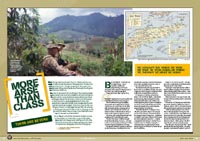 |
When things
went bad in East Timor in 1999, Australia was ready to react. Given the
scale of the operation, the reaction was relatively swift – though,
listening to the media, who wanted everything done ‘yesterday’,
one might be forgiven for thinking otherwise.
One has to remember that nothing on this scale had been attempted by the
Australian Defence Force since Vietnam.
We also went in as an Australian-led multinational force –although
we had UN sanction, it was not a UN mission – which was also a unique
experience for what was essentially a peacetime defence force depleted
by evertightening
annual budgets. The Army in particular was the poor cousin at the budget
table at that time.
None of this big-picture stuff meant much to the guys on the ground, however.
They, as usual, were the mushrooms – kept in the dark and fed bullshit.
As a rifleman with 3RAR, Shane Van Duren was one of the soldiers on the
bottom rung of the ladder, expected to hit the ground running, but with
little solid info on what was actually going on.
But then, for he and his colleagues, that was nothing new...
Words Shane
Van Duren and Brian Hartigan
Pics ADF
|
|
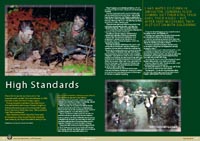 |
Shane
Van Duren saw service as part of the International Force East Timor as
a rifleman in 3RAR, and later joined the French Foreign Legion.
During a lengthy interview for another story in this special issue, I
felt some of Shane’s insights on infantry life were too good to cull,
yet didn’t quite fi t into the flow of that other story – ‘More
arse than class; Timor and beyond’.
Here, therefore, is what Shane Van Duren sees as the essence of service
and the high standards maintained by the Royal Australian Infantry Corps...
Words Shane
Van Duren and Brian Hartigan
Pics ADF
|
|
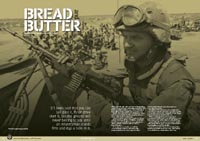 |
It’s
been said that you can sail past it, fly or drive over it, but the ground
will never belong to you until an infantryman stands firm and digs a hole
in it.
While respecting the other services and supporting corps, I must say I
believe this statement is true and that even in the most non-conventional
situations this is still and will probably always be the case.
But I’m also a firm believer in Mr Murphy, whose holy laws of combat
don’t always shine down in favour of the lowly infantryman.
After two solid years of close-country and junglewarfare training with
the 1st Battalion, I probably should have expected that we were going
to be deployed to the desert in northern Africa – thanks Murphy.
From day one in country we did it all – humanitarian missions, defended
water points, protected convoys, manned vehicle check points, kicked in
some doors and yes, even dug a few holes...
Words AJ
Shinner
Pics ADF and Shinner collection
|
|
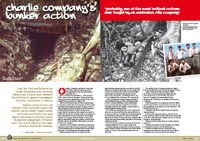 |
Long Tan,
Coral and Balmoral are names synonymous with Australian bravery and, in
many cases, represent the full extent of general knowledge of Australia’s
involvement in Vietnam.
However, during January and February 1968, Australian regular and national
service soldiers fought another battle that could easily have gone down
in the annals of history as one of the greatest engagements of the war,
were it not overshadowed by the bigger picture of the first Tet Offensive.
Operation Coburg was another in a long series of Australian search-and-destroy
missions designed primarily to protect the American base at Bien Hoa.
Three Australian infantry battalions – 2RAR, 3RAR and 7RAR –
were involved in Operation Coburg and all three saw heavy and prolonged
fighting over the course of the operation from 24 January to 1 March 1968...
Words Brian
Hartigan
Pics Supplied by Mark Moloney
|
|
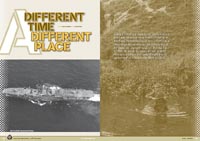 |
It was
1968 in the Republic of South Vietnam and I was on active service with
1st Battalion the Royal Australian Regiment – 1RAR – as a rifle-company
commander.
We were proud of our battalion. Initially raised in Morotai for occupation
duties in Japan, we had already seen active service in Korea, Malaya and
an earlier tour of Vietnam, the latter in 1965.
Our battalion was, in many respects, like a large family – I
had known and served with my sergeant major on and off for 15 years and
knew many others as well. Half of our soldiers were national servicemen
– all of them good young men who came with us willingly, worked hard
and bonded as mates as only infantry soldiers can. We were very pleased
with them, and their grandfathers would have liked them for what they
were too.
My advance party had arrived at Nui Dat around mid March, settled in and
been on several interesting operations into Baria with 7RAR, who we were
relieving.
With the main body in place, we commenced zeroing our weapons, attended
intelligence briefings and kept up a constant patrol programme outside
the wire...
Words Colin
Adamson
Pics ADF and AWM
|
|
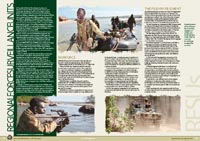 |
In the
early 1980s, the Army began to pay more attention to the northern regions
of the nation and eventually raised Regional Force Surveillance Units,
based on a squadron/troop structure, in the Northern Territory, Western
Australia, and north Queensland. RFSUs were created with the aim of filling
a gap in the ground surveillance capability of Australia’s northern
defence.
It was recognised that a force operating in this austere environment would
require special knowledge and skills that regular forces do not readily
possess and so, a key feature of the RFSU concept was the valuable contribution
that Indigenous people could make to the Defence of Australia, as they
did during WWII.
Many Indigenous communities are located in remote areas or close to
remote vital assets and, as such, can provide invaluable local knowledge
to RFSU patrols operating right across the north and west of the continent.
For a number of reasons, the Pilbara Regt has been less active in the
employment of Indigenous people, however NORFORCE and 51FNQR boast a high
percentage of Indigenous members – 25 to 35 per cent and 45 to 58
per cent respectively. The RFSUs have the highest Indigenous representation
of any other ADF organisation, and possibly any other Australian Government
agency outside of ATSIC.
It is now well accepted that many Indigenous people, and indeed non-Indigenous
people living in remote Australia are not able to meet the strict criteria
for enlistment and service in the wider ADF. Literacy, numeracy and health
standards preclude many from meeting these stringent requirements. However,
to follow these standards rigorously would deny the RFSUs access to a
large portion of a sparse recruiting base, effectively negating the original
concept...
|
|
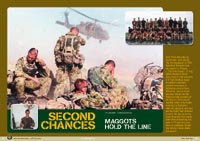 |
East Timor
was only my second ever ‘real’ callout. The first happened in
1998. Operation Brancard saw the mighty 12 Platoon – ‘The Dirty
Dozen’ – D Coy, 2RAR, deploy to RAAF Base Darwin, with elements
of 4 Field Battery, ready
to conduct a servicesassisted evacuation of Australian citizens from Indonesia.
Like so many previous callouts for the longer-serving members of the platoon,
Op Brancard resulted in the Dirty Dozen returning to Townsville when the
weekend was over and the RAAF had returned to work.
We had no stories to tell from that first outing other than of sneaking
into town in PT gear for some beers in downtown Darwin (yes Brady, I knew
where you were!)...
So, when 2RAR went into lockdown in September 1999 for a battalion
callout, I thought it might be Op Brancard revisited. Then the media coverage
really started to intensify.
Coverage of the failing UNAMET (United Nations Mission in East Timor)
and the escalating violence, particularly in Dili, looked serious.
Suddenly, there was a real feeling that the whole battalion might actually
be going somewhere
Words Adam
Rankin
Pics Supplied by Adam Rankin, and ADF
|
|
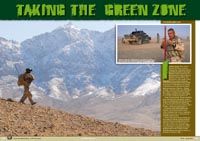 |
It’s
early spring 2008, close to the Baluchi Pass in southern Afghanistan.
Australian infantry, providing security to engineers building a patrol
base, are out of their pits and moving. 7 Platoon, Charlie Company, 2RAR
– the Unforgiven – are on patrol.
Only days ago, Charlie Company backed by cavalry, bushmasters and
mortars, fought the enemy to a standstill here in a series of defensive
actions that saw the entire battle group dig in. 9 Platoon – the
Bad Tourists – took the brunt of the first attack and 7 Platoon repelled
the final assault. The Taliban extremists had, as the official account
said, ‘rolled the dice and lost’.
Today, Lieutenant Ben Watson is pushing his troops hard before they pull
out and return to Australia after a tough six-month rotation. They patrolled
last night, they patrolled this morning, they’ll patrol again tonight
– and they’re patrolling now.
In denying enemy the initiative and freedom of movement, they’re
doing what Australians have done on defensive operations since WWI –
dominating the operating environment.
For the Unforgiven, that’s nothing new.
They spent the winter securing the high reaches of the Chora Valley through
the harshest conditions in living memory, according to the locals, while
the Taliban extremists laid low, enabling the Aussie engineers and locals
to build Forward Operating Base Locke, right in the face of an enemy reluctant
to fight...
Words Al
Green
Pics ADF
|
|
Plus...
- News
- Photos
- Bardia
Barracks - the Ingleburn Connection
- RAR Battalion
histories
- Infantry
Corps Structure
|
